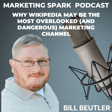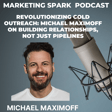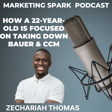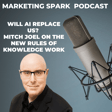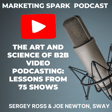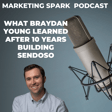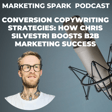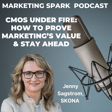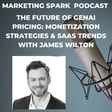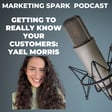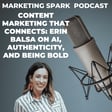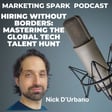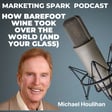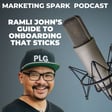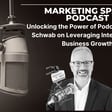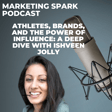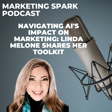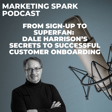Become a Creator today!Start creating today - Share your story with the world!
Start for free
00:00:00
00:00:01

What Happens When Your Audience Disappears? - PizzaTime
PizzaTime's business exploded during the pandemic as companies looked for ways to engage remote employees.
The company, which offers catering to remote teams, reaped the benefits and transformed itself into a high-growth entity.
But as more people start going back to the office, PizzaTime has to re-strategize.
In this episode of Marketing Spark, Matthew Carnevale talks about the different marketing growth tools being applied.
This includes doubling down on customers and referrals, leveraging a blog and newsletter, and talking to customers on a regular basis.
Transcript
Pizza Time's Founding and Early Challenges
00:00:06
Speaker
Sometimes companies emerge out of necessity. An entrepreneur has a problem and creates something to fix it. Pizza time is a prime example. In 2017, Josh Gross ran a digital agency called Planetary. He wanted to throw a pizza party for his team, which worked and worked remotely around the world. Took some manual work, and the experience was so good that Gross realized that he was onto something.
00:00:34
Speaker
In 2019, Planetary launched Pizza Time, which would organize virtual pizza parties for distributed teams. It was a good idea, but the timing was wrong, so gross shelved the program. And then COVID emerged.
00:00:50
Speaker
And Josh's team went about reviving Pizza Time. The order started to roll in. To get some insight into Pizza Time and how it attracted new customers and how it's driving sales, I'm excited to be talking to Matt Carnivale, Head of Growth for Pizza Time.
Meet Matt Carnivale: From One Local to Pizza Time
00:01:06
Speaker
Welcome to Marketing Spark. Hey Mark, thanks for having me. Yeah, you pretty much nailed the story there, but yeah, I appreciate you having me on and obviously super excited to chat about my journey with Pizza Time.
00:01:18
Speaker
Why don't we start by talking about how you arrive to pizza time. You've been there since last September. What were you doing before? What was it like starting a new job at a time when everybody is and was working remotely? I started my career in marketing about three years ago or four years ago at a company, One Local. One Local is a small business marketing software company. I actually started in sales and then after about six months transitioned into growth.
00:01:48
Speaker
There, I was doing everything from sales enablement, partnerships, content, you name it, everything in between. And then, yeah, last summer, I stumbled upon Pizza Time. I thought they had a really cool story. They seemed to hit the growth pedal at the right time. So I figured it was a good time to jump on board. My last company was
00:02:08
Speaker
We had a big sales team. We are a software company venture backed and you know piece of time is quite the opposite We actually have zero sales reps We're fully bootstrapped and we're more of a service company as opposed to software for the uninitiated people who haven't used pizza time it's described to me how the service works and What are the use cases? What kind of customers or what kind of companies are taking advantage of the service?
00:02:36
Speaker
In essence, Pizza Time is a virtual catering company. We supply food and drinks for remote meetings for employees across the world. In terms of how it works, it's pretty straightforward. Let's say somebody has a meeting with their remote sales team that's spread across North America or even global.
00:02:56
Speaker
They'll just let us know the date and time of the meeting. And then we send out an invite to all the attendees across the world. And then at the time of the meeting, we just send out food to everybody. And we lean on local delivery apps, whether it's DoorDash, Uber Eats, or internationally, whoever their local delivery partners are.
00:03:17
Speaker
Yeah, in terms of the use cases, like I said, it can be for internal meetings, it could be, you know, virtual socials, happy hours, or even virtual conferences and webinars is a big use case as well. So you find this new opportunity, you get excited about what pizza time is doing.
Defining Growth Strategies at Pizza Time
00:03:34
Speaker
What were your biggest growth priorities and challenges going into the job? What were they looking for you to do? Because obviously, during COVID, the idea not only resonated, but it got some traction.
00:03:48
Speaker
And as a bootstrap company, obviously every dollar counts. So when they hired you, what were they looking for you to do? And what did you see as some of the things that you needed to do as a growth person to get the company to the next level? Yeah, great question. So when I was brought on, you know, I was pretty much hired to define our growth strategy.
00:04:11
Speaker
So we were essentially at the time doing very, very little marketing. A lot of the growth for Pizza Time was product-led. People would use our product, and the word would spread throughout big companies, or people would use us in virtual conferences, and then attendees at the conference would go use us for their own company. So that's how our growth happened before I joined. And then when I joined, it was like, OK, let's figure out how to keep growing and tap into new channels.
00:04:40
Speaker
For me, it was my first time ever doing that, even though I came from another startup. So really, the first couple of things I was looking to do was, OK, let's go talk to some customers. Let's get an idea for what problem we're solving and why they already buy from us and where they buy from. Another big one was looking at the data. So looking at what already exists, whether that's our Google Analytics or CRM, anything like that. And then from there, some of the things that emerged from that discovery was
00:05:10
Speaker
I had to pretty much set up our data structure. So we had some data in our CRM, but none of it was appended to any of our marketing software like Sengrid, et cetera. So I had to make sure that we had all the proper data so that I could run campaigns and they would actually look like targeted personalized campaigns.
Adapting to Market Changes and Challenges
00:05:30
Speaker
But another big project that I kind of worked on in the very beginning, and this kind of taps into your point of us not having a massive budget where we can waste money, is
00:05:41
Speaker
I set up a re-engagement funnel and email re-engagement funnel. So anybody who hadn't purchased from us in greater than 90 days, they were added to an email sequence, which essentially re-incentivize them to make a purchase with us.
00:05:56
Speaker
I was like a four step sequence and it's still running to this day and it still helps us recover, you know, two to three new customers every single week. And the reason why I think it was great, a great project to work on from day one was because I wasn't, I didn't need to ask for any marketing budget. Um, I didn't need to ask for, you know, ad budget, whatever. It's just like, Hey.
00:06:14
Speaker
I'm going to create this sequence and it's going to recoup some old customers. And I think people tend to look at new customers as a way to impress your boss, hey, I could bring new customers to the business, but a great place to start for an early marketer is who are the people who haven't showed up for demos or haven't bought in a while and let's try and get them back into our funnel. It usually leads to some early wins early on. I think that's one of the things about new marketers
00:06:43
Speaker
When they start, there's an expectation that they're going to deliver results. But the reality is you have to build confidence. You have to make your boss recognize that you've got some ideas.
00:06:55
Speaker
that you are gonna grow in the long term, but in the short term, you're looking for quick wins. And if you can do that really in a cost-effective way, that's even better. So did you find that that re-engagement exercise helped validate what you wanted to do and gave the organization some more confidence in marketing?
00:07:15
Speaker
Yeah, I would say so. Already within the first couple of weeks of it running, we were able to get some purchases on the board. And I think as a marketer, everything you do ideally is going to be tied back to revenue. So if in the first couple of weeks, you could already show the CEO, hey, I've already paid back a bit of my salary. I think that's a really, really great win.
00:07:39
Speaker
So you've been there for about eight months. What does your job look like in terms of your priorities and challenges versus eight months ago? Eight months ago in the online world, in this COVID world, it's fluid and dynamic and there's no such thing as anything written in stone. Everything's sort of written in sand. What are the biggest changes that you've had to make or things that you've had to pivot on or maybe programs that you've had to launch?
00:08:07
Speaker
I would say overarching, our service is really dependent on remote companies needing it. That's where our demand is derived from.
00:08:18
Speaker
In the last eight months, a lot of companies have sent employees back to work, back to work in an office. So people who may have been our customers eight months ago are no longer our customers. And our total addressable market has shrunk over the last eight months, which is obviously never easy to deal with. But I think from a strategy standpoint, in the past, it was like, hey, if you are an HR director or if you are a team leader, we have this great tool that's going to help you
00:08:45
Speaker
increase morale and build engagement in your team we can no longer use those broad approaches now we have to get a lot more targeted so you know for example if we did a cold email campaign in the past we can just collect emails for any hr director cuz every company's remote.
00:09:03
Speaker
Now what we have to do is we have to look at, you know, intent data. So we have to look at, you know, uh, is this company actually hiring remote employees? If we are, we know they're remote companies. So then we can hit them up with an email and say, Hey, we got this great tool for you. Um, so I'd say like overarching, like high level speaking. Now I have to get a lot more targeted in who I go after. And I have to look for those and scrape those intent signals. Whereas in the past, I had the luxury of assuming, you know, 99% of companies were fully remote.
00:09:33
Speaker
So that's really interesting when your total addressable market shrinks dramatically in a short period of time and your entire sales and marketing effort is built on this certain type of behavior and that is no longer the case. So one of the questions that I'm curious to have you answer is intent data. Where does that come from? What sources do you access and scrape? Where do you get that data?
Expanding Services and Marketing Tactics
00:09:58
Speaker
I would say, like I mentioned, the big one is looking at job boards. If a company, they usually will say beside the job posting remote, or if not in the headline, they say it's somewhere in the posting. So let's say whether it's on site.
00:10:14
Speaker
hybrid or remote that's a really really valuable data point for us and you know something we can pull off the web whether it's manually or to tech so that's a really big one for us another one like i mentioned the big use case for product is virtual conferences and virtual webinars. Well a lot of companies post online you know where are if they're having a virtual conference upcoming.
00:10:37
Speaker
So we can do some reverse engineering there, right? Let's say company XYZ is having a virtual conference in June, then we can look for the contact on LinkedIn. We can get their email and then we can hit them up with an email saying, Hey, like we know you have a conference in three months. You know, we have this great tool that's going to allow you to do X. Why don't we have a conversation? So those are kind of the two bigger ones, you know, on the topic of virtual events and webinars, there's
00:11:03
Speaker
sites like Eventbrite, which gives us a huge list of virtual events upcoming. So we just try to tap into that usually. So I'm clear. Is pizza time just pizza or do you cater all kinds of different foods and beverages and things like that?
00:11:20
Speaker
We actually have five different services. I'll just really, really quickly walk through them. So we have our pizza time service, which is pizza delivery to remote employees across the world. We have a lunch service, which is just an expanded menu. So it's like pizza, burgers, salads, things like that.
00:11:37
Speaker
We also do coffee and pastries for morning meetings. We have alcohol delivery for happy hours. And then we also have virtual experiences. So it can be like a hosted bingo or trivia or something like that. Obviously remote employees, remote events are the sweet spot for pizza time. What about all the people going back to the office? After two years away, you would think that a lot of HR managers and a lot of
00:12:05
Speaker
bosses in general want to do things to build culture and teamwork and make people feel connected to the organization again. Is that an opportunity for Pizza Time to tap into that demand to get your employees feeling like a team all over again? So we definitely have explored supporting
00:12:26
Speaker
on-site team building or even hybrid company team building. But the only reason it's not as attractive for us is because we're a super niche product and we've always done well because we're so niche and specific.
00:12:39
Speaker
there's already companies who are really, really good at, you know, team building for in office companies. And we, we just think it would be a lot tougher to compete there. We know like we've already carved out our part of the market, and we know we do it well. And you know, a lot of people are loyal to us specifically for what we do. So it's not to say we would never consider it. But at the moment, virtual only is still our priority for the foreseeable future. So over the past eight months,
00:13:06
Speaker
What have been some of the biggest challenges that you've run into as a growth marketer? The market has changed on you. It's shifting as we speak right now. Has it been the need to pivot? How have you quantified when the time is to do things differently? Talking about the marketing channels that you're leveraging and some of the ones that you're now starting to explore.
00:13:29
Speaker
Like it kind of goes back to a point about, you know, the total dressable market has shrunk. So five months ago, you know, I would run a campaign on Facebook that targeted, you know, I use detailed targeting and anybody that was a HR manager, director or whatever was somebody who was a good fit for us.
00:13:45
Speaker
So now we can no longer do that. So some of the things that we're trying to tap into now is, you know, more specific bottom of funnel activities. So an example is we're building out a bunch of landing pages that target, you know, really specific keywords that only get like, you know,
00:14:03
Speaker
ten to thirty searches a month but the reason we're doing that is because those are the searches are so specific and we're really one of the only companies that can solve that issue so we're putting time and effort to invest in those because we know that we can actually solve that problem we're starting to you know we know a lot of our growth has come from our existing customers but we're putting a lot of effort now behind our referral program.
00:14:25
Speaker
I'm because like i said it you know the top of final is not as clear to us anymore we don't we don't know one hundred percent who needs a product who doesn't so we're letting your existing customers feel that growth. And the reason why we're betting on our existing customers being able to do that is because our customers work and you know big companies.
00:14:44
Speaker
and across these big companies you know a lot of the policies are the same so for example if you know amazon has one remote team that uses us well there could be hundred other that could use us within the company cuz we know amazon's a company that accepts remote remote working so for us we're betting on the fact that you know our customers are gonna know other people other employees who are also. Remote first and spread the word of pizza time throughout their own company in their own networks.
00:15:13
Speaker
Couple of questions, couple of follow-up questions. One is, in terms of the landing page strategy, without giving away state secrets, can you give me an example of a long tail keyword that you're building a landing page for? Because obviously, if someone's looking for something like that, even if it's really, really nichey and you're the result that comes up, that is great in terms of conversion. Can you provide an example of how that works in the real world? A really specific example would be,
00:15:39
Speaker
How do I send pizza to remote employees across the world? I know it's kind of our spiel in our pitch, but that's something that it's not a high volume search whatsoever. I think it gets like 70 searches a month now. We're the only company who does it. It definitely works well for us. You know, another example is how do I send lunch to people who are in my remote sales kickoff meeting? Like something as long tail is that it's not something that everybody searches, but again, we're one of the only companies who can fulfill that.
00:16:09
Speaker
So you know that that's worked really well for us. If you have a really good idea of your existing customer base and you can re target them and re engage them that's awesome and that will drive obviously hopefully land and expand kind of strategy but what about top of the funnel feels like there's a lack of clarity or is not as much clarity as
Engaging Customers Through Content and Feedback
00:16:30
Speaker
you had.
00:16:30
Speaker
you know, six or eight months ago or a year ago, is it a bit of a guessing game right now? What's your strategic approach to trying to drive top of the funnel activity when you're not really sure who it's going to land with? Like who is actually that target audience? Sounds like a really tough way to operate as a marketer. Yeah, it's super tough. It's gotten increasingly more difficult. And it's even difficult because, you know, I don't have a sales team
00:16:58
Speaker
working side by side with me. So, you know, my last company, we had like 20 something sales reps doing cold calls every day. So we're getting a lot of immediate feedback as to what's going on in the market. Well, I'm not getting that. So what I've done is our blog strategy is super top of funnel. I know I said, like, we're working on landing pages that target long tail keywords, but our blog strategy is actually very top of funnel. And the reason we're doing that is I'm almost treating every blog post like a sales rep, like
00:17:28
Speaker
It's out there answering some broad question to somebody. Those posts are doing a lot of that top of funnel work and getting a lot of that attention. And then from there, what we can do is we could actually put a Facebook pixel on those blog posts and retarget the people that don't convert or don't take another action off that initial blog post. So yeah, majority of our top of funnel efforts are put into our blog right now. It's interesting because blogs aren't terribly sexy.
00:17:54
Speaker
And I think a lot of companies have even backed off blogs for e-books and obviously creating a lot of content on LinkedIn these days. So what is the blog strategy? What are you trying to do with it? How many times do you post? What do you do with your blog posts in terms of distribution and repurposing content? That'd be really interesting to get some insight into somebody who's actually leveraging blogs in a very effective way. It sounds like that's what you're doing.
00:18:19
Speaker
So in terms of the actual strategy itself, like I said, the keywords and topics that we're targeting are a lot higher level than those very specific landing pages. So an example would be like, how do I create camaraderie among my remote team? Or how do I keep remote employees engaged? That's a super high level topic. We're not even expecting somebody to convert off that post per se, but we're getting attention from HR managers, directors, people like that.
00:18:47
Speaker
So that's kind of the keywords and topics that we're going after.
00:18:51
Speaker
Right now, we're posting once a week, so quite frequently, and we use external writers to fulfill the content. So that's it for the actual writing itself. In terms of distribution, we repurpose a lot of our content for LinkedIn. Albeit, we don't have a big following. We don't get a ton of engagement, but we're trying to build up toward it. But another really big distribution channel for us is our newsletter. And I know that newsletters are not necessarily some new innovative tactic, but
00:19:21
Speaker
What we found, and I'm happy to touch more upon this, is when you send emails at roughly the same time every month with a bunch of value packed into them, the open rate for them starts to go up quite significantly. I know this for myself. Whenever I get newsletters that I think are really, really good, I won't even open them until I'm ready to read the entire thing. I'll either star them or leave them on unread.
00:19:44
Speaker
So we've shifted away from like spammy email strategy to now like packing in all of our good blog content into there and not even really asking for a conversion like we're not saying here's a great blog post but also by our product it's like here's just value just here is like something great to read and are open rate is gone up and you know with that overtime we've seen our engagement within our newsletter go up to.
00:20:07
Speaker
Yeah, I'm a big believer in newsletters. I just think the idea of touching your customer on a regular basis and providing value added information is has so many so many good benefits. And I would love to get the pizza time approach to the newsletter. How often do you send it? What kind of content are you putting into the newsletter? Is it all native content? Do you create content? What's the overall? What are you trying to do? And how do you do it?
00:20:35
Speaker
Yeah, yeah, great question. So we send it once a month. We send it on the third Thursday every month. So even though our customers aren't paying attention to that somewhere in their brain, it's predictable. What I do is since we post once a week in our blog and our newsletter goes out once a month, I summarize our four blog posts in, you know, maybe one paragraph or in a couple of bullet points. So what I do is I'll go through the content and I'll say like, OK,
00:21:04
Speaker
If I had to summarize this, what would I write? And I just rewrite that or have somebody rewrite it. So we have our most important snippets from every single post. So if somebody were to skim it, that's what they'd get from it. To summarize our blog content, I usually, I'll include maybe a link to another really interesting article that's not ours. So I'll give a backlink somewhere, do something like I'll talk about what we just launched or what we're working on right now because
00:21:31
Speaker
Our genuine belief is that our customers care about that. I mean, they care about what it does for them, but, uh, we believe it's something that our customers want. So we're okay talking about that and not making it too salesy. And then last but not least, I always like to include some sort of funny meme or joke in there just to kind of make them smell or lighten up their day. And, you know, I'll also talk about what pizza time has in store for the coming month. So it's kind of like a summary of like a bunch of great content and then, you know, what's next.
00:21:59
Speaker
and some other stuff they may find useful. So in terms of drawing the list, customers will automatically be opted into the newsletter and they can opt out if they want to. Yeah, that's how we've treated it. And how do you add non-customers who may want to be part of the experience? Do you try to do that at all? Is that part of the overall growth strategy?
00:22:20
Speaker
Yeah, totally. So what we'll do is like if we're running other, let's say we're doing like a Facebook campaign and you know, somebody had, you know, opted in to receive some emails from us, but never converted. Those are people we'd move over to our newsletter and we'll let them know like, Hey, unless you explicitly say you don't want to be included, we're going to add you to our newsletter going on next month.
00:22:41
Speaker
And not too many people drop off. So we have that directly on our blog page. There are people who you could sign up right from there. So we have a subscribe option right from our newsletter. And then, you know, in other conversations with customers here and there or people who aren't customers, I'll always encourage them. Hey, like check out our newsletter just to say in the loop. Yeah, that's pretty much the couple of ways in which we get people into a newsletter. So in terms of channel perspective, you've got the weekly blog.
00:23:08
Speaker
You leveraged some of the content for LinkedIn. You're running the newsletter. What are the other marketing channels that you're deploying? High level. We've been looking at, or we've been beefing up our referral program a lot, like I'm saying. So we're using our existing customers a ton. Another big one that we've done, which has worked pretty well for us was we're running a campaign on Instagram.
00:23:36
Speaker
where we are targeting HR directors and leaders. What we were saying to them was, hey, if you work remotely, we have a great, obviously, service that helps you build morale and engagement. And to prove it to you, we'll send you a free lunch. You just have to attend our weekly webinar. So we would actually use our product. They would go through the process themselves of signing up for a lunch and receiving food. And then in the weekly webinar, I would just spend 10, 15 minutes talking a bit about pizza time and how they can
00:24:04
Speaker
place an order and our pricing and stuff like that. And that's worked really well for us. You know, we can't pour thousands of dollars into it. So it's a slow, it actually is slow growth strategy, but the uptick has been really good because we're putting our money, you know, where our mouth is. The other thing I wanted to ask you about is in terms of how do you quantify the success of your marketing efforts? What are some of the North Star that you have identified and what are some of the KPIs that you and your boss have
00:24:33
Speaker
decided that is how they're going to assess whether you're actually doing your job well or not. So I would say the biggest one, the North Star metric for us is quarterly transactions, not revenue. Obviously, we want to see revenue go up. But the way our service works is our average order value or our order value is
00:24:56
Speaker
Really dependent on how many people the person is ordering for so if you're ordering food for a team of 10 people versus 100 Obviously the 100 is gonna be a much bigger order But what we actually want to see is are more people buying our service. It's not
00:25:13
Speaker
are there big orders because we can't control how big the person's team is. Our North Star metric is definitely transactions, not revenue. We want to see that going up month over month. As an add-on, again, we have those five different services that I mentioned earlier. We want to see product awareness for those go up. A lot of our customers, when I found out, when I originally joined, was they've used our pizza product, but they didn't even know we had a coffee product. A big thing of mine is from day one, I want to build product awareness.
00:25:43
Speaker
What are some of the biggest lessons that you've learned over the last couple of years, both things that you've learned because things have gone well, the things that you've learned because some things haven't gone as well as expected? So I'd say the biggest one for me is like 80% of projects, or at least in my stage of a company, 80% of projects are going to fail and 95% aren't going to be right the first time.
00:26:05
Speaker
Um, that was a tough pill to swallow, but, um, you know, it's kind of comforting knowing that, Hey, like the majority of things aren't supposed to work anyway, but it's about finding the 20% that's going to. And if something doesn't work on day one, that's okay. Like change it and try it again. It's not just about giving up right away. So.
00:26:21
Speaker
that was really big one another big one is your customers are your best friend gotta go in and talk to your customers from day one and then keep doing it every single week forever don't stop they're gonna tell you what to work on they're gonna tell you how to market to them what to write what problems to write about so that was a really big one and then very very last was just understanding the data so having a really good understanding of like
00:26:45
Speaker
you know depending on what your company is you know what your monthly revenue is what your turn rate is what you repeat purchase rate is everything like get a good understanding that when you're in those conversations with your team and your ceo you can back up your decision making with data as opposed to just your thoughts.
00:27:03
Speaker
I love that you mentioned talking to customers as a key element for your success because it's something that I talk about a lot. And it's something that I see a lot on LinkedIn because a lot of marketers don't know their customers very well or at all. And I think is that they operate in a silo. They're busy tapping on their keyboards and looking at their dashboards and using different tools, but they don't engage with customers.
00:27:29
Speaker
Like, how do you find out what your customers are thinking and what they want, what they don't want to you? What's the tactical approach to doing that? You know, really simply, what I do is, you know, I go into our CRM, I look at our customers for the last 50 days and I just I rent, I don't hand pick, I just randomly choose people that have purchased. They could have used this once or 100 times, doesn't matter to me. And all I ask them for is 15 minutes of their time. No gift cards, nothing. Most people are willing to help.
00:27:57
Speaker
And it's just a matter of asking them why they use their product, what problems do we solve for them, asking them how they found us, asking them for just general feedback, good and bad, asking them how their team like using us.
00:28:14
Speaker
Yeah, I just try and, you know, I make the conversation as natural as possible, but it's just getting an idea of like, okay, why do you use us? How did you find us? And, you know, generally, you know, would you use this again? Why or why not? What are some things we can improve on?
00:28:28
Speaker
And the reaction is pretty positive when you do the outreach and ask them to jump on a call with you. Uh, of course, um, you know, the majority of people don't get on the call, but we still have like a 20%, I would say yes rate. And I've never had anyone say like, you know, stop, this is annoying. Everyone seems to be a cool with it. So we've had a really good uptick.
Working Remotely in a Remote-First Company
00:28:47
Speaker
Curious about the fact that you work for a company that serves people who work remotely. Have you ever met anybody who works for.
00:28:55
Speaker
planetary or pizza time and if so, what was that like? No, I haven't. It kind of sucks. I mean, I'm a people person and I definitely like meeting people in person. My last company, I had a blast with my colleagues and some of them are still some of my best friends to date. It's a challenge for sure. I'm not going to sugarcoat it. I wish I could meet them in person and it's definitely something that I look for is meeting my colleagues in person.
00:29:20
Speaker
Well, I can think that maybe an excuse to go to Brooklyn might be a good thing down the road at some point in time. Yeah, yeah, exactly, exactly. This has been a great conversation. Where can people learn about you and Pizza Time?
00:29:33
Speaker
You can visit my LinkedIn, Matthew Carnivale, Pizza Time, Toronto, Ontario. In terms of Pizza Time itself, go to www.pizzatime.xyz. And, you know, if you ever want to reach out to me specifically about anything Pizza Time related, my email is super simple. It's my first name, Matthew with two T's at pizzatime.xyz.
00:29:54
Speaker
Thank you, Matthew, for all the great insight. I love talking to marketers who can really get into the weeds and talk about how they're doing things, what works, what doesn't. Thanks everyone for listening to another episode of Marketing Spark. If you enjoyed the conversation, leave a review, subscribe via Apple Podcasts or your favorite podcast app, and share via social media. To learn more about how I help B2B SaaS companies as a fractional CMO, strategic advisor, and coach, send an email to mark at markevans.ca.
00:30:23
Speaker
or connect with me on LinkedIn. I'll talk to you soon.
